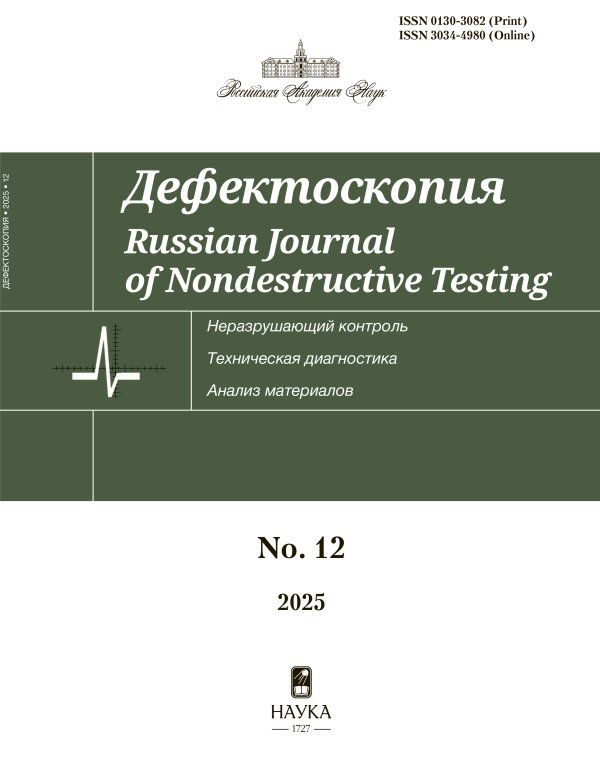Параметрическое исследование моделей обнаружения аномалий для выявления дефектов в инфракрасной термографии
- Авторы: Весала Г.Т1, Гхали В.С2, Нага прашанти Ю.2,3, Суреш Б.2
-
Учреждения:
- Университет Малларедди
- Образовательный фонд Конеру Лакшмайя
- Институт инженерии и технологий им. Дханекулы
- Выпуск: № 12 (2023)
- Страницы: 12-25
- Раздел: Статьи
- URL: https://journal-vniispk.ru/0130-3082/article/view/233689
- DOI: https://doi.org/10.31857/S0130308223120023
- EDN: https://elibrary.ru/XEZEIV
- ID: 233689
Цитировать
Полный текст
Аннотация
Об авторах
Г. Т Весала
Университет Малларедди
Email: gopitilak7@gmail.com
Хайдарабад, Телангана, Индия
В. С Гхали
Образовательный фонд Конеру ЛакшмайяВаддесварам, штат Андхра-Прадеш, Индия
Ю. Нага прашанти
Образовательный фонд Конеру Лакшмайя;Институт инженерии и технологий им. ДханекулыВаддесварам, штат Андхра-Прадеш, Индия
Б. Суреш
Образовательный фонд Конеру ЛакшмайяВаддесварам, штат Андхра-Прадеш, Индия
Список литературы
- Aldrin C. John.Intelligence augmentation and Human Machine Interface (HMI) best practices for NDT 4.0 reliability / In ASNT Annual Conference, Westgate Las Vegas Resort & Casino, Wsetgs Las Vegas, Nevada. 2019.
- Maldague X.P.V. Theory and Practice of Infrared Technology for Non-Destructive Testing. New York: Wiley, 2001.
- Ciampa Francesco, Mahmoodi Pooya, Pinto Fulvio, Meo Michele. Recent advances in active infrared thermography for non-destructive testing of aerospace components // Sensors 18. 2018. No. 2. P. 609.
- He Yunze, Deng Baoyuan, Wang Hongjin, Cheng Liang, Zhou Ke, Cai Siyuan, Ciampa Francesco. Infrared machine vision and infrared thermography with deep learning: A review // Infrared Physics & Technology. 2021. V. 116. P. 103754.
- Luo Q, Gao B, Woo WL, Yang Y. Temporal and spatial deep learning network for infrared thermal defect detection // NDT & E International. 2019. V. 108. P. 102164.
- Hu Bozhen, Gao Bin, Lok Woo Wai, Ruan Lingfeng, Jin Jikun, Yang Yang, Yu Yongjie. A lightweight spatial and temporal multi-feature fusion network for defect detection // IEEE Transactions on Image Processing. 2020. V. 30. P. 472-486.
- Saeed Numan, King Nelson, Said Zafar, Omar Mohammed A. Automatic defects detection in CFRP thermograms, using convolutional neural networks and transfer learning // Infrared Physics & Technology. 2019. V. 102. P. 103048.
- Wei Ziang, Fernandes Henrique, Herrmann Hans-Georg, Tarpani Jose Ricardo, Osman Ahmad. A deep learning method for the impact damage segmentation of curve-shaped cfrp specimens inspected by infrared thermography // Sensors 21. 2021. No. 2. P. 395.
- Fang Qiang, Ibarra-Castanedo Clemente, Maldague Xavier. Automatic defects segmentation and identification by deep learning algorithm with pulsed thermography: Synthetic and experimental data // Big Data and Cognitive Computing 5. 2021. No. 1. P. 9.
- Wei Ziang, Fernandes Henrique, Tarpani Jose Ricardo, Osman Ahmad, Maldague Xavier. Stacked denoising autoencoder for infrared thermography image enhancement / In 2021 IEEE 19th International Conference on Industrial Informatics (INDIN), IEEE, 2021. P. 1-7.
- Cheng Liangliang, Kersemans Mathias. Dual-IRT-GAN: A defect-aware deep adversarial network to perform super-resolution tasks in infrared thermographic inspection // Composites Part B: Engineering. 2022. P. 110309.
- Tretout H., David D., Marin J. Y., Dessendre M., Couet M., Avenas-Payan I. An evaluation of artificial neural networks applied to infrared thermography inspection of composite aerospace structures // NDT and E International 6. 1996. No. 29. P. 392.
- Lakshmi A. Vijaya, Gopi tilak V., Parvez Muzammil M., Subhani S.K., Ghali V.S. Artificial neural networks based quantitative evaluation of subsurface anomalies in quadratic frequency modulated thermal wave imaging // Infrared Physics and Technology 97. 2019. P. 108-115.
- Lakshmi A. Vijaya, Ghali V.S., Subhani Sk., Baloji Naik R. Automated quantitative subsurface evaluation of fiber reinforced polymers // Infrared Physics & Technology 110. 2020. P. 103456.
- Vesala G.T., Ghali V.S., Lakshmi A. Vijaya, Naik R.B. Deep and handcrafted feature fusion for automatic defect detection in quadratic frequency modulated thermal wave imaging // Russian Journal of Nondestructive Testing. 2021. V. 57. No. 6. P. 476-485.
- Liu Lishuai, Guo Chenjun, Xiang Yanxun, Tu Yanxin, Wang Liming, Xuan Fu-Zhen. A semisupervised learning framework for recognition and classification of defects in transient thermography detection // IEEE Transactions on Industrial Informatics 18. 2021. No. 4. P. 2632-2640.
- Morelli Davide, Marani Roberto, D'Accardi Ester, Palumbo Davide, Galietti Umberto, D'Orazio Tiziana. A Convolution Residual Network for Heating-Invariant Defect Segmentation in Composite Materials Inspected by Lock-in Thermography // IEEE Transactions on Instrumentation and Measurement. 2021. V. 70. P 1-14.
- Tilak V. Gopi, Ghali V. S., Lakshmi A. Vijaya, Suresh B., Naik R. B. Proximity based automatic defect detection in quadratic frequency modulated thermal wave imaging // Infrared Physics & Technology. 2021. V. 114. P. 103674.
- Vesala G.T., Ghali V.S., Sastry DVA Rama, Naik R.B. Deep anomaly detection model for composite inspection in quadratic frequency modulated thermal wave imaging // NDT & E International. 2022. V. 132. P. 102710.
- Munir Mohsin, Chattha Muhammad Ali, Dengel Andreas, Ahmed Sheraz. A Comparative Analysis of Traditional and Deep Learning-based Anomaly Detection Methods for Streaming Data / In 2019 18th IEEE International Conference On Machine Learning And Applications (ICMLA). IEEE, 2019. P. 561-566.
- Sch�lkopf Bernhard, Platt John C., Shawe-Taylor John, Smola Alex J., Williamson Robert C. Estimating the support of a high-dimensional distribution // Neural computation. 2001. V. 13. No. 7. P. 1443-1471.
- Liu Fei Tony, Ting Kai Ming, Zhou Zhi-Hua. Isolation forest / In 2008 eighth IEEE international conference on data mining. IEEE, 2008. P. 413-422.
- Breunig Markus M., Kriegel Hans-Peter, Ng Raymond T., Sander J�rg. LOF: identifying density-based local outliers / In Proceedings of the 2000 ACM SIGMOD international conference on Management of data. 2000. P. 93-104.
Дополнительные файлы










